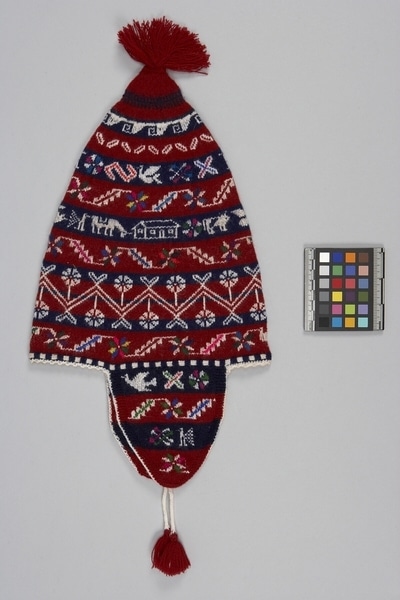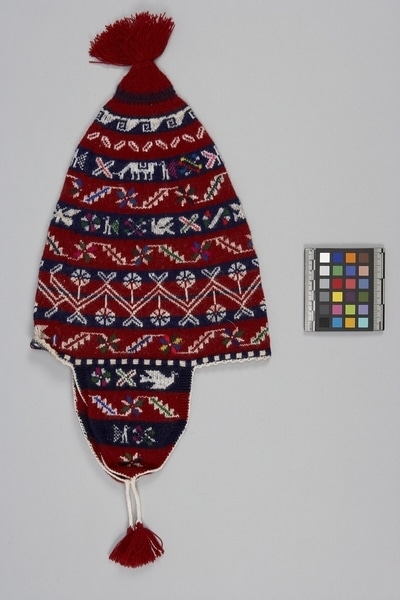Hat Item Number: Sf946 from the MOA: University of British Columbia


Description
Cap with ear flaps and tassels on the top and pendant from the ear flaps. Geometric and figurative designs worked primarily in white with multicoloured accents cover the alternating blue and red horizontal bands. Eight part florets joined by stepped oblique lines repeat in three of the red stripes. Birds, butterflies, camelids, cows, houses, as well as circles, crosses and s-shapes appear in the blue stripes.
History Of Use
The colour, extent of patterning, shape and the manner in which chullus or caps are worn signal differences in age, sex and status of the wearer. Females wear chullus in early childhood, but only males wear them later in life. Traditionally, knitting is done only by men and boys, formerly for chullus, but recently also for vest fronts, coin purses, gloves, ties, vests and sweaters which are sold to tourists. The fully patterned red and blue cap is worn by married men. The style with ear flaps is an older style not so much used today. The earflaps of older hats had stars on them.
Specific Techniques
Plain knitting done circularly on five needles with extra colours carried on the inside for local colour areas.
Narrative
Bought from the Asociacion Artesanal "Maneo Capac" Taquile, the textile co-operative in the community. The cap has been worn but not very much.
Iconographic Meaning
The range of motifs refers to local geography and landmarks, ecology, fecundity as well as luck. The six part circle refers to the division of land into six sections on Taquile and the rotation of crops and fallow periods. The s or z shaped reverse curve can refer to the boat port or other objects that contain the idea of turning or returning such as a recurved potato hook. The cross or x-shape can refer to the warping cross in weaving, the crossroads or other intersections. The stepped diagonal lines refer to stairs on the steep island, but also to the connection with the afterworld in a particular myth. The motifs represent basic concepts or interrelationships and may have different particular references.
Cultural Context
Married men; old style.
Item History
- Made by Simon Quispe Flores (Maker) in Taquile, Puno, Peru during 1982
- Collected by Mary Frame during 1984
- Owned by Mary Frame before May 8, 1986
- Received from Mary Frame (Seller) and Museum of Anthropology Shop Volunteers (Funding source) on May 8, 1986
What
- Name
- Hat
- Identification Number
- Sf946
- Type of Item
- hat
- Material
- synthetic fibre and dye
- Manufacturing Technique
- knitted and sewn
- Overall
- height 54.0 cm, width 24.0 cm
Who
- Culture
- Quechua
- Creator
- Simon Quispe Flores (Maker)
- Field Collector
- Mary Frame
- Previous Owner
- Mary Frame
- Received from
- Mary Frame (Seller) and Museum of Anthropology Shop Volunteers (Funding source)
Where
- Holding Institution
- MOA: University of British Columbia
- Made in
- Taquile, Puno, Peru
When
- Creation Date
- during 1982
- Collection Date
- during 1984
- Ownership Date
- before May 8, 1986
- Acquisition Date
- on May 8, 1986
Other
- Item Classes
- textiles
- Condition
- good
- Accession Number
- 1131/0008